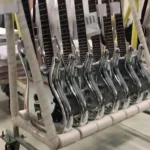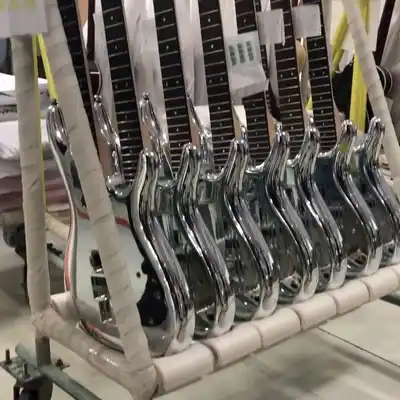
Ibanez Factories
Ibanez, a name synonymous with innovative guitar design and exceptional craftsmanship, has a fascinating history that spans over a century. The brand’s success can be attributed to its commitment to quality, which is deeply rooted in its manufacturing processes and choice of factories. Let’s delve into the expansive world of Ibanez factories and their significant contributions to the guitar industry.
Table of Contents
1. The Early Days: Hoshino Gakki
The history of Ibanez is intrinsically linked to the Hoshino Gakki company. Founded in 1908 by Matsujiro Hoshino in Nagoya, Japan, the company initially sold sheet music and then imported Spanish guitars. By the 1930s, Hoshino began manufacturing their own stringed instruments under the Ibanez Salvador brand, marking their foray into guitar production.
The story of Hoshino Gakki is one of transformation, resilience, and an unwavering commitment to musical excellence. Spanning over a century, Hoshino Gakki’s journey from a humble bookstore to one of the world’s most recognized musical instrument manufacturers is nothing short of remarkable.
1.1. Humble Beginnings
Founded in 1908 by Matsujiro Hoshino in the city of Nagoya, Japan, the company’s initial foray wasn’t in musical instruments but in the sale of books. It was originally named “Hoshino Shoten” which roughly translates to “Hoshino Bookshop”.
1.2. Stepping into the World of Music
Hoshino’s shift towards music began when they started importing and selling Spanish guitars. Recognizing the growing interest in Western music and instruments in Japan, the company quickly pivoted to cater to this new market demand.
1.3. Crafting Under the Brand “Ibanez”
By the 1930s, the Hoshino company had ventured into manufacturing its own instruments. The guitars they produced were labeled “Ibanez Salvador”, a name that would later be shortened to just “Ibanez”. The origins of the name “Ibanez” trace back to Salvador Ibáñez, a Spanish luthier whose guitars Hoshino initially imported and sold. As a tribute, and perhaps for its exotic appeal, the brand name was adopted for Hoshino’s own line of guitars.
1.4. Post-War Expansion and Innovation
The post-WWII era saw a surge in the popularity of Western music in Japan, particularly rock ‘n’ roll. Hoshino Gakki responded by increasing its production capabilities and introducing innovative designs to cater to the new generation of musicians. It was during this period that they began partnerships with factories like Fujigen, laying the groundwork for what would become iconic Ibanez guitar models.
1.5. The “Lawsuit Era” and Reinvention
The late 1960s and early 1970s are often dubbed the “lawsuit era” for Ibanez and Hoshino Gakki. This is because Ibanez produced high-quality replicas of popular American guitars, leading to legal challenges from companies like Gibson. However, these challenges propelled the company into a new era of originality. Hoshino Gakki invested in new designs, leading to the birth of now-iconic Ibanez models.
1.6. Global Expansion and Modern Era
From the late 1970s onward, Hoshino Gakki expanded Ibanez’s presence globally. Collaborations with guitar virtuosos like Steve Vai and Joe Satriani resulted in signature models that pushed the boundaries of guitar design. Hoshino Gakki’s commitment to craftsmanship and innovation ensured Ibanez’s position at the forefront of the guitar industry.
2. Fujigen Factory
The relationship between Ibanez and the Fujigen Gakki factory stands as one of the most influential partnerships in the history of electric guitar manufacturing. Together, they’ve crafted instruments that have not only shaped the sound of multiple generations but have also redefined the boundaries of guitar craftsmanship.
2.1. The Genesis of the Partnership
Established in 1960 in the city of Matsumoto, Nagano, Japan, the Fujigen Gakki factory originally focused on classical guitar production. It wasn’t until the late 1960s and early 1970s that Fujigen began its long-standing collaboration with Hoshino Gakki, the parent company of Ibanez.
2.2. The Quality Revolution
At the dawn of their collaboration, Ibanez was primarily producing replicas of popular American guitars. Fujigen’s involvement brought a marked increase in quality, rivaling and, in some cases, surpassing the American originals. This superior craftsmanship in the “lawsuit” guitars laid the foundation for the brand’s reputation in the international market.
2.3. The Birth of Original Designs
Post the “lawsuit era”, Ibanez and Fujigen transitioned from replicating existing designs to pioneering their own. This phase saw the emergence of legendary guitar models like the Ibanez RG, S series, and the Artist. Fujigen’s capability to manifest intricate designs and ensure consistent quality played a crucial role in the success of these models.
2.4. The Golden Era
The 1980s and 1990s are often seen as the golden era of the Ibanez-Fujigen partnership. Together, they introduced innovative features like the Super Wizard necks, Edge tremolo systems, and unique pickup configurations. The JEM and Universe models, designed in collaboration with guitar virtuoso Steve Vai, are testaments to their combined innovative prowess.
If you’re looking to buy a guitar from the ’80s or ’90s, one of the first steps in assessing its authenticity is to use the Ibanez serial number lookup tool.
2.5. Master Craftsmanship
Fujigen is not just about large-scale production; it’s also about master craftsmanship. The Ibanez J Custom series, which represents the pinnacle of Ibanez’s quality and craftsmanship, saw its birth in the Fujigen factory. These instruments showcase the intricate detailing, exceptional tonal characteristics, and unmatched playability that Fujigen is renowned for.
2.6. Fujigen Today
Beyond its association with Ibanez, Fujigen has a notable reputation in its own right. The factory crafts its own line of guitars and has provided OEM services for many other renowned brands in the guitar industry. Their legacy of excellence continues, embodying the spirit of Japanese craftsmanship.
3. Korean, Indonesian, Chinese Factories
While Japanese craftsmanship set the gold standard for Ibanez’s professional-grade instruments, the brand expanded its manufacturing to other parts of Asia to cater to different market segments. Factories in Korea (such as Cort and Saehan/Sungho), Indonesia (like PT. Wildwood), and China have been instrumental in producing budget-friendly, yet quality Ibanez guitars, especially the Gio series.
3.1. Korea: The 1980s and Beyond
- Initiation: By the late 1980s and early 1990s, Ibanez started to shift some of its production to Korean factories. This move was driven by the economic rise of Japan, which made manufacturing more expensive in the country.
- Key Factories: The most notable of these factories was Samick, which produced a substantial number of Ibanez guitars during this period. Another significant contributor was Cort.
- Quality & Models: The Korean-made Ibanez guitars were typically more affordable models. While they didn’t always carry the prestige of the Japanese-made counterparts, they were well-regarded for their price-to-quality ratio.
3.2. Indonesia: A Key Player from the 1990s Onwards
- Expanding Horizons: As the costs in Korea began to rise, Ibanez started looking to other countries to continue its strategy of producing quality guitars at a more affordable price point. By the late 1990s and early 2000s, Indonesia had become a central hub for Ibanez guitar production.
- Factories: PT Cort, an Indonesian branch of the Cort company, and PT Samick, an extension of the Korean Samick brand, became primary producers for Ibanez in Indonesia. Additionally, PT Saehan, which later transformed into PT Sinarindo, also contributed to the production.
- Diverse Range: Over time, the quality of Indonesian-made Ibanez guitars improved significantly. Today, Indonesia produces a wide range of Ibanez guitars, from budget-friendly options to more premium models.
3.3. China: The New Millennium’s Production Giant
- Emerging Powerhouse: By the 2000s, China had become an undeniable force in global manufacturing. Recognizing the country’s potential, Ibanez began to produce a portion of its guitars in Chinese factories.
- Factories & Collaboration: One of the significant factories in China producing for Ibanez is the Zhangzhou Stronghold – a large manufacturer known for producing a variety of stringed instruments. Collaborating with such factories allowed Ibanez to maintain its quality standards while benefitting from the cost-effective production China offered.
- Focus: Chinese factories primarily produce entry-level and budget-friendly guitars for Ibanez. These instruments cater to beginners and intermediate players looking for a quality instrument without breaking the bank.
